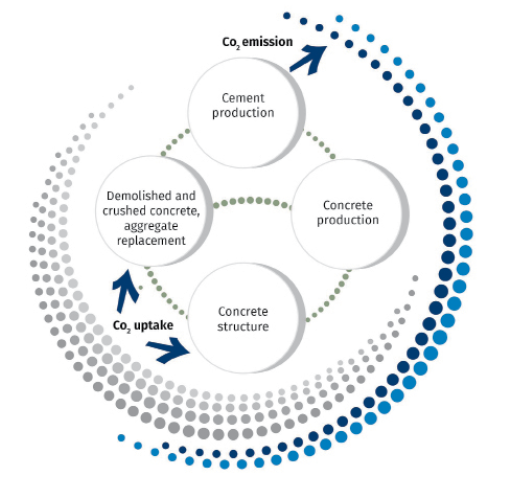
structures, crushed concrete or demolition debris. The carbonation metric will contribute to the formula indicating precast concrete’s
carbon neutrality.
In a new position statement on members’ material usage, production methods and embrace of circular economy principles, the Federation of the European Precast Concrete Industry (BIBM), Brussels, reinforces commitment to fostering a sustainable and low-carbon society. The BIBM Decarbonization Pledge represents “a concerted effort to minimize environmental impact across the entire lifespan of precast concrete products” and signatories’ quest “to lead the path in reducing carbon emissions in the construction sector, emphasizing the crucial role the industry plays in global environmental stewardship.” Core Pledge commitments center on:
- Construction Work. Pledge highlights the need to consider CO2 emissions reduction throughout a project’s lifecycle and giving producers or other precast concrete value chain stakeholders the means to achieve decarbonization.
- Circular Economy. Pledge considers how end-of-life processes minimize the industry’s environmental impacts and stresses an approach that stretches material use, reduces waste and, true to circular economy ideals, seeks to decouple economic growth from resource use.
- Stakeholder Cooperation. Pledge champions sustainable practices throughout the precast element or structure lifecycle, encompassing design, fabrication, and distribution or delivery phases. It likewise recognizes that every value chain step contributes to the overarching decarbonization goal.
- Enabling Policy Framework. Stakeholder and policymaker collaboration is crucial for achieving decarbonization in the built environment, and rests on an enabling framework rooted in science and material neutrality.
The Federation headquarters office prepared the Decarbonization Pledge with the BIBM Environment and Communication Commissions. Officials view the document as a milestone in a journey toward a more sustainable future and an indicator of how precast concrete interests “are not only meeting the demands of the present but also safeguarding the environment for generations to come.” The organizations comprising BIBM represent producers employing more than 7,000 across the European Union and report annual shipments upwards of $33 billion.
The document is posted at www.bibm.eu.

REGULATOR OUTREACH TOPS GLOBAL CEMENT AND CONCRETE ASSOCIATION PRIORITIES
Cemex S.A.B. de C.V. CEO Fernando González has been elected to a two-year term as president of the Global Cement and Concrete Association (GCCA), London. “It is a great honor,” he notes, “particularly as we enter this ‘decade to deliver,’ a period during which we must accelerate our decarbonization efforts. My number one priority as president of GCCA is to collaborate closely with governments and industry to evolve the regulatory framework in ways that promote a more circular, lower-carbon economy.” That echoes sentiments expressed in September during the United Nations General Assembly’s Private Sector Forum, where he linked a regulatory ecosystem and the cement industry reaching its full potential as a contributor to a carbon neutral society.
Among additional 2024-2025 priorities for GCCA, whose members account for 80 percent of global cement production outside of China, González underscores:
- Encouraging regulation that diverts municipal and industrial waste from landfills to waste-to-energy solutions, including substitution of fossil fuels in cement kilns.
- Promoting building codes and practices that allow the extensive adoption of lower-carbon cement and concrete products.
- Establishing market-driving carbon pricing mechanisms that incentivize decarbonization and investment in carbon reduction technologies.
- Seeking funding and alliances to develop new technologies that reduce carbon emissions in cement production and accelerate carbon capture, utilization, and storage method scaling.
González has served as GCCA vice president since 2018 and succeeds his Holcim Ltd. counterpart, Jan Jenisch, as president. Along with Cemex and Holcim, GCCA members with North American market stakes include Buzzi Unicem, CRH, GCC, Heidelberg Materials, Taiheiyo Cement (CalPortland), Titan Cement Group and Votorantim Cimentos.